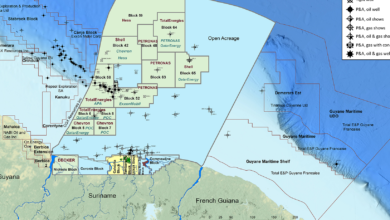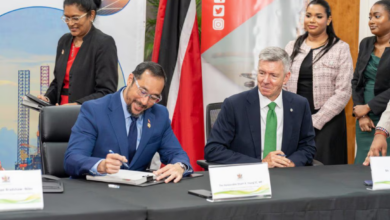Shale drilling reaps efficiency gains from MPD pressure control
As in deepwater, precise management of BHP opens door to optimized mud weights, ROP in onshore unconventionals
By Brian Grayson, Weatherford

Managed pressure drilling (MPD) techniques that are used to drill some of the world’s most extreme conventional wells also have the capability to significantly improve drilling efficiency in unconventional shales.
MPD wellbore pressure monitoring and control overcomes the inherent hydrostatic pressure burden imposed by conventional overbalanced circulating systems for well control and stability. By safely reducing pressure at the bit face, MPD provides the means to significantly improve drilling performance and penetration rates in shales. Optimizing mud weight and managing pressure-related events in this manner lowers costs and speeds field development time. In some applications, it has reduced drilling time by nearly 50%.
Enhancing the shale process
As the geological and well construction challenges in a shale reservoir become more familiar, improvements in efficiency increasingly require a shift toward an assembly line approach. In this mode, with fewer surprises to reduce efficiency, refining the process depends on removing NPT from the assembly process and driving out invisible flat time and unrealized efficiencies in the manufacturing process.
This industrial engineering approach to improve the shale process involves the consideration of many input variables that together determine the mechanical specific energy (MSE) required to drill the rock. Industry effort has been expended on improving drilling efficiency by understanding MSE, focusing on optimization through control of factors, such as weight on bit, rotational speed, torque and bit hydraulics. While these optimizations have greatly enhanced drilling efficiency, much more remains to be gained by addressing a legacy source of inefficiency – hydrostatic pressure.
The weight of the fluid column in the wellbore has a significant adverse affect on MSE and rate of penetration (ROP). But in conventional overbalanced drilling systems that are open to the atmosphere, mud weight is critical to well control and stability management. Reducing it, typically, is not acceptable, even for a much needed gain in efficiency. MPD provides a way to circumvent this quandary by safely minimizing mud weight.
Within a closed-loop circulating system, MPD enables very precise, real-time monitoring and control of downhole pressure at a much lower mud weight than required with a conventional system. By reducing the degree of wellbore overbalance, MPD reduces rock strength and thus improves drilling efficiency and ROP.
In South Texas and northwest Louisiana, a study of different technologies used to safely and economically optimize shale-drilling operations found that MPD was very effective. The ability to reduce mud weight in South Texas shale wells improved ROP from 10 ft/hr to 20 ft/hr to 50 ft/hr to 80 ft/hr. In Louisiana’s Haynesville shale, MPD wells averaged approximately five days in lateral sections, while conventional drilling required approximately 9.5 days. The improved efficiency resulted in an overall reduction of 44% in drilling days.
The performance led the operator to conclude that the lower mud weights and higher pump rates achieved in the MPD wells were central to optimizing hydraulics, improving hole cleaning, lowering bottomhole temperatures and enhancing drilling performance overall.
Understanding specific energy

affect drilling efficiency.
The MSE required to drill ahead is optimized when it is roughly equal to the compressive strength of the formation. Achieving this balance is complicated by many variables, including the adverse affect of bottomhole pressure (BHP) on rock strength and the difficulty of managing the pressure.
R. Teale first presented this MSE concept in a 1965 paper on coal mining in Great Britain, along with an equation for specific energy that is the basis for much of the related research. A simple version of this equation for expressing mechanical specific energy is:
Specific Energy e = (W/A) + (2π/A)(NT/μ)
W = weight on bit in psi
A = the area of the hole in sq in.
μ = ROP
N = RPM
T = torque
R. Teale’s work, “The Concept of Specific Energy in Drilling Rock,” showed that the MSE required to drill the rock is roughly equal to the compressive strength of the rock at atmospheric pressure. This unconfined compressive strength is how rock strength or hardness is commonly characterized. However, the rock strength encountered by the bit in oil and gas drilling is typically different than UCS. Instead of atmospheric pressure, the rock is subjected to the pressure of the fluid column in the wellbore. Thus, the rock strength at the bit face is actually confined compressive strength.
The effect of wellbore hydrostatic pressure can be substantial. As BHP increases, the rock is compressed and becomes harder, which increases the amount of specific energy required to drill the formation. Pessier et al in 1992 established that this could dramatically affect drilling characteristics and MSE calculations. His studies on specific energy and drilling efficiency demonstrated that significantly greater ROP could be achieved when drilling with less hydraulic or differential pressure (Figure 1).
Mud weight impact

Because greater fluid density adversely affects the rate of penetration, as well as bit hydraulics and hydraulic horsepower, the rheological, physical and chemical properties of the fluid system are a key focus of drilling efficiency analysis.
Multiple regression analysis by Bourgoyne et al in 1974 examined drilling data obtained over short intervals to derive an expression that is useful in relating mud density changes to variations in ROP:
Log (R/RO )=a4 D(gp-ρc )
a4 = a single co-efficient (-0.052m)
D = depth
gp = the formation pore pressure
gradient (ppg)
pc = mud density at the cutter (ppg)
A simplified version of this equation demonstrates the effect of hydrostatic overbalance on ROP and why greater rates are achieved in underbalanced conditions:
ROP2 = ROP1 ecD(MW1-MW2)
c = a constant based on bit type,
formation and WOB or slope of the shale
line
D = depth
MW1 = mud weight at ROP1 (ppg)
MW2 = mud weight at ROP2 (ppg)
Bourgoyne’s 1991 plot of drilling rate versus mud column pressure for Berea sandstone shows that ROP or drilling rate is significantly higher at lower wellbore pressures (Figure 2). The deeper formation has higher strength due to compaction, and higher mud density is required to maintain wellbore stability and well control. The greater wellbore pressure results in slower ROP as drilling progresses into deeper and more overpressured rocks.
Bourgoyne’s equation was used to calculate ROP with different mud weights. Two scenarios were described in a plot of ROP versus depth, and mud weight versus depth for a shale formation with slope of shale line of c = -0.000666. In the first scenario, drilling from 15,000 ft to 18,000 ft required an increase in mud weight from 14.1 ppg to 17.1 ppg. The second scenario assumes drilling the same depth interval with a constant 14.1-ppg mud weight. With increasing mud weight, ROP is reduced significantly. In contrast, a constant mud weight of 14.1 ppg results in a considerably higher ROP although the depth interval is the same (Figure 3).
MPD application
IADC defines MPD as an adaptive drilling process used to precisely control the annular pressure profile throughout the wellbore. Its objective is to ascertain downhole pressure limits and to manage the annular hydraulic pressure profile accordingly so that any formation influxes are mitigated before reaching the surface.
Real-time monitoring and control of BHP and equivalent circulating density (ECD) is a key aspect of this adaptive drilling process. In deepwater wells, where margins between pore pressure and fracture gradient are very narrow, this enables precise management of the pressure profile along the wellbore in real time without the need to change mud weight. In shale applications, this control allows drillers to safely reduce the amount of hydrostatic overbalance for improved ROP and increased drilling efficiency.
MPD is based on a pressurizable closed-loop circulating system in contrast with conventional rig circulation systems that are open to the atmosphere. Within the confines of a closed loop, downhole pressure fluctuations are immediately detectable at the surface. A response is achieved by applying annular backpressure. Similar to stepping on an automobile brake pedal, pressure changes at the surface are felt immediately downhole. The methodology enables precise control of BHP without the delay, imprecision and cost of conventional changes in mud weight.
An MPD system consists of only a few components, depending on the application. Key parts of the system include a rotating control device (RCD), which in land applications sits atop the BOP to redirect annular flow to an automated MPD choke manifold.
A computerized control system integrates the MPD components to monitor, analyze and manage wellbore pressure. It collects real-time data about micro-fluctuations in pressure and flow from various instruments, including mass flow Coriolis meters. By manipulating the MPD choke, the control system can automatically provide highly accurate and reliable pressure management of BHP and ECD.
Implementing an MPD system does not interfere with conventional mud and BOP pressure control. Instead, the system acts as a first line of response to pressure fluctuations. The flexibility of this response facilitates a variety of MPD methodologies for mitigating many pressure related conditions.
These MPD methods include simple applications for enhancing safety, as well as ways to maintain constant bottomhole pressure (CBHP), drill with total circulation losses with pressurized mud cap drilling and manage BHP with dual-gradient drilling (DGD).
In shale drilling, CBHP methods provide the means to precisely manage BHP. This is the same pressure control technique used to navigate narrow drilling windows in deepwater wells. By monitoring and managing dynamic and static fluid states in the closed-loop system, the methodology controls hydrostatic pressure within precise parameters. Manipulating surface backpressure and altering pump rates allows BHP to be varied within a considerable range. This allows mud weight to be safely minimized to achieve the best ROP and efficiency.
New efficiency opportunity
The large number of shale wells being drilled around the world means that additional drilling efficiencies achieved in the development process can have a significant economic impact. While many improvements have been made to drilling efficiency, the challenges posed by mud weight have not been effectively addressed because of the critical function hydrostatic pressure plays in well control and stability. MPD provides an alternative means of safely controlling wellbore pressure and optimizing stability, while reducing the burden imposed by mud weight. Doing so significantly opens a new opportunity to improve drilling efficiency and ROP in shale wells.
This article is based on a presentation at the 2013 IADC MPD & UBO Conference & Exhibition, 17-18 April, San Antonio, Texas.




